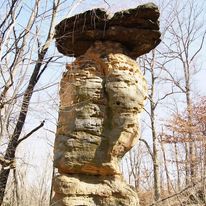Skip links
Main navigation
Jug Rock
The free-standing, rare table rock formation known as the Jug Rock. The Incredible natural geological rock formation, Jug Rock, composed of sandstone, located in Shoals near the East Fork of the White River.
As the largest free-standing table rock formation (also called a “tea table”) in the United States east of the Mississippi River, the Jug Rock has created a great deal of interest in geological circles. One of the earliest accounts known to us was published in 1871 in the Second Report of the Geological Survey of Indiana by state geologist E.T. Cox. He wrote:
“One of the most interesting spots to visit, for obtaining a view of this character of scenery, is near the town of Shoals, on the road to the Indian Sulphur Springs. A high ridge of millstone grit, here, terminates within a few yards of the East Fork of White river, from the top of which, there is a projecting mass of conglomerate sandstone, called the “Pinnacle,” which stands one hundred and seventy feet above the level of the stream. Cyclopean blocks, that have broken off, lie around the foot of the ridge, in every conceivable position. On the north side of this ridge, the conglomerate has been cut through by disintegrating forces, which left, at some distance from the main ledge, a tall mass of rock, which has received the name of “Jug Rock,” from the fancied resemblance which it bears to a jug. It is 60′ high and supports, on its top, a flat projecting layer, which is called the “stopper.” Just above the bulge of the jug are irregular lines of stratification, known as false bedding. The lower part is thickly set with quartz pebbles.”
Quote and information from http://en.wikipedia.org/wiki/Jug_Rock
Facts:
Jug Rock, overall dimension is 60′ high and 20′ in diameter. The Pinnacle is the front part of the original sandstone formation that eroded to form Jug Rock. Jug Rock stands alone with no adjacent ledge, which classifies it as one of the most puzzling formations, known as “Stand Rocks,” in the United States.





